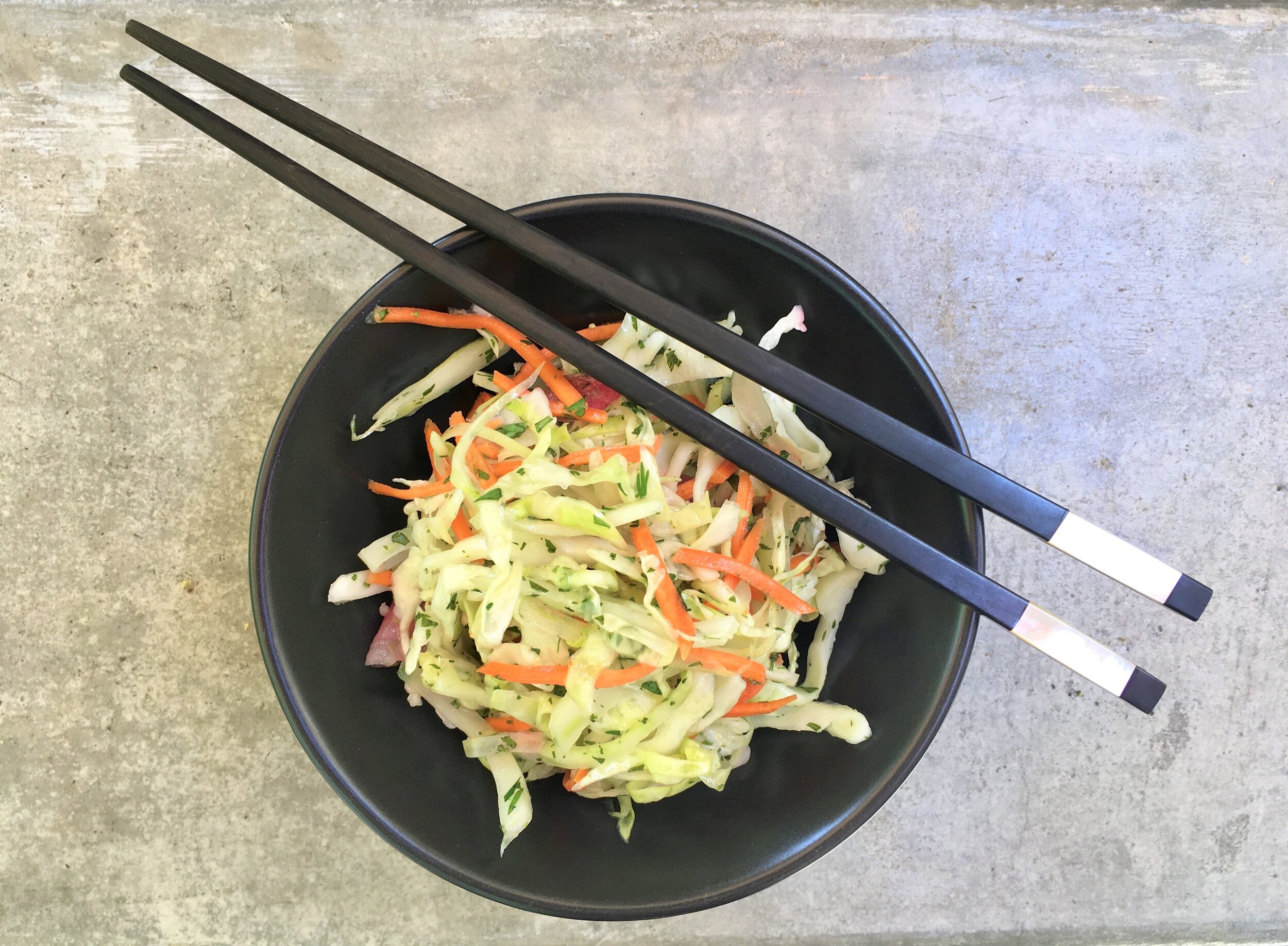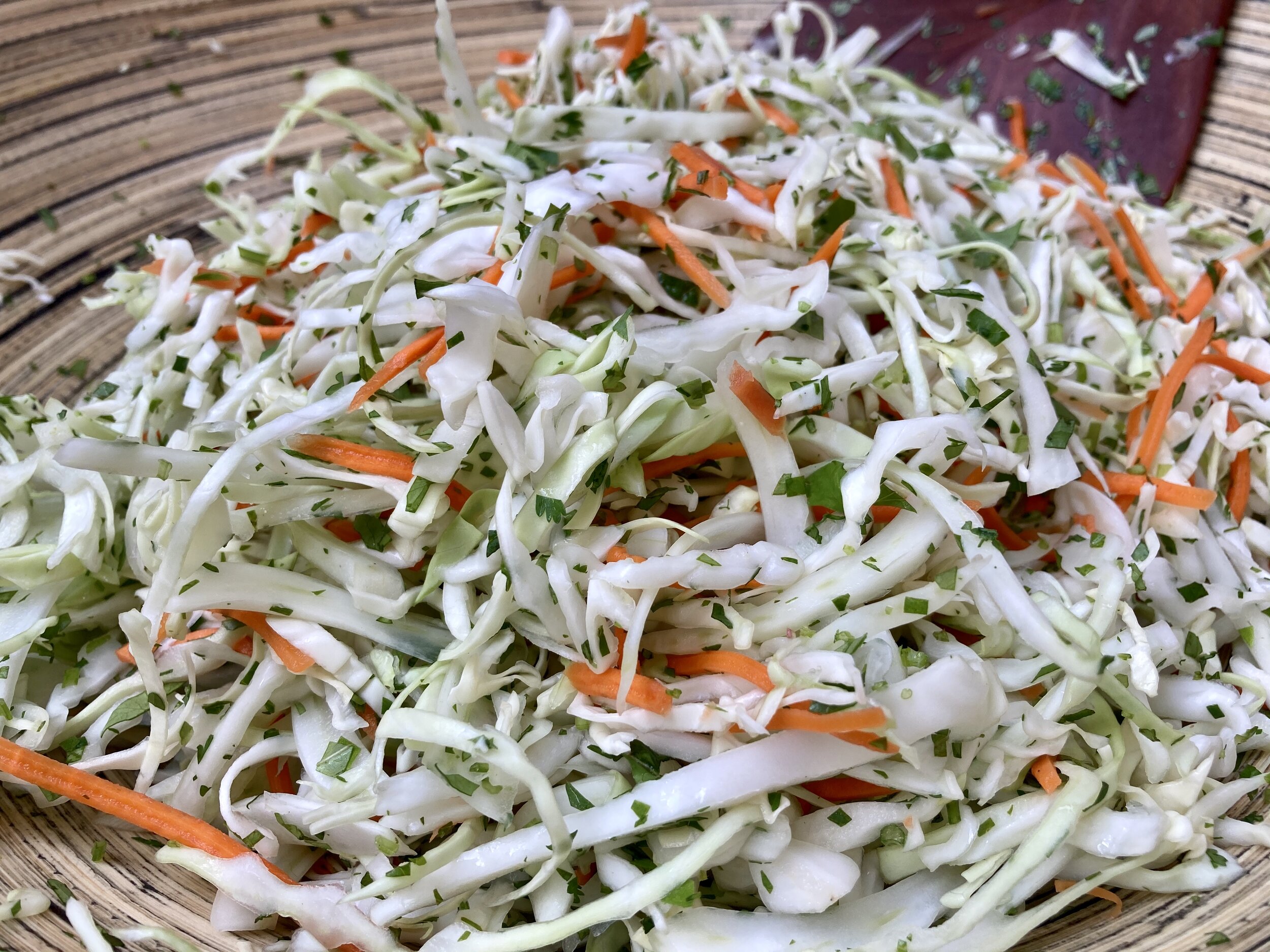The Ultimate Cabbage Slaw
Optimized for BBQ, Fried Chicken, and Vietnamese Dinner Parties
I’m not a fan of American-style coleslaw. Fortunately, I discovered a long time ago that the Vietnamese have a tradition of raw cabbage salads that partner flawlessly with all the dishes I’d expect to see coleslaw alongside. Fried chicken. Barbecue. Pulled pork sandwiches. Thanks to all the fresh herbs and aromatics involved, Vietnamese gỏi bắp cải is fabulously crunchy, tangy, healthy and — most importantly — delicious. Garlic, chilies, fish sauce, fresh herbs and vinegar perk up green cabbage like nothing else on earth.
I’ve eaten many, many variations on this dish in Vietnamese restaurants in the U.S. and Vietnam. Some are enriched by chopped nuts (peanuts or cashews), poached shrimp or chicken, and/or fried garlic and shallots; others are kept spare and light to brighten up the richer dishes they’re accompanying. In its lighter iterations, it makes an awesome topping for tacos, tostadas and sandwiches (try it with pulled pork!).
The versatility of this slaw is phenomenal. It’s really the Meryl Streep of salads.
The recipe that follows is my go-to, bare-bones version for summer barbecues or hot weather dinners. The optional fried shallots are well worth your time (if you have it to spare), both as a topping and for the depth of flavor the shallot-frying oil adds to the dressing. Both the shallots and their oil keep beautifully for weeks — stored separately — in the refrigerator, so you can make a big batch and savor it at your leisure.
This slaw’s tangy freshness makes the perfect foil for succulent, smoky ribs or barbecue…
… but it also rocks as a healthy main event salad topped with poached shrimp or chicken.
If I’m making this slaw to partner with fattier meats (fried chicken, barbecue, etc.), I’ll keep the amount of oil in the dressing at the low end indicated in the recipe. If the slaw is itself dinner, or topped with leaner grilled proteins, I’ll lean the other way with the oil to make sure there’s enough richness to feel satisfying. It’s a very forgiving recipe — you can make a passable dressing with lemon juice or just rice wine vinegar instead of lime, and if you don’t have fresh chilies, just use black pepper or hot sauce.
For me, this dish is best made with finely sliced cabbage (what’s called “angel hair” in the pre-packed bags in the supermarkets), and finely shredded carrots. Thicker-cut veggies feel clumsier in the mouth, and don’t carry the flavors as well. And before you ask, YES — if you’ve got pickled carrots in your fridge for peanut butter banh mi sandwiches, absolutely use them here! I usually do. Pickled red onions are also a nice addition.
As a fennel maniac, I almost always put finely sliced fresh fennel bulb in with the cabbage, and more herbs if I’ve got ‘em (fresh Thai basil, rau ram, and even a bit of shiso are all great additions). But when cilantro-haters are present, or the herb options are slim, a little bit of mint or even basil can carry it. Don’t get too exuberant with the amount of mint or basil you use, though, because their flavors can easily dominate the salad in an unpleasant way.
Pro tip: If you sneak in some slivered red cabbage and red/orange/yellow bell peppers, you’ve got yourself the perfect rainbow Pride Party salad. The recipe doubles easily; just be careful with the chilies in the dressing.
There are links in the recipe below to products I recommend. As an Amazon Associate, I may earn a commission (at no additional expense to you) from qualifying purchases.
The Meryl Streep of salads — ready for its next delicious role.
Vietnamese Slaw
Serves 4 as a side dish
Lime-Garlic Dressing
1 large garlic clove
Small pinch of salt
2-3 Tbsp freshly squeezed lime juice, to taste
2 Tbsp sugar
2 Tbsp fish sauce (I like Three Crabs and Red Boat)
2 Tbsp rice wine vinegar
2-4 Tbsp (depending on salad’s intended use) oil from frying shallots, or plain neutral oil like grapeseed or peanut
¼ tsp freshly ground black pepper, or more to taste
Very finely minced fresh chilies (Thai, bird’s eye, serrano, or jalapeno) to taste
Slaw Base
5 cups (about 10 oz) finely shredded fresh green cabbage (“angel hair” cut)
1 cup finely shredded fresh (or pickled) carrots
About 8 sprigs fresh cilantro
About 2 sprigs fresh mint
¼ cup fried shallots or chopped toasted peanuts (optional)
Make the Dressing
Use the flat side of a chef’s knife to crush the garlic clove with a pinch of salt. Pound (carefully!) on the flat side of the knife several times to help break down the cell walls, and then mince as finely as possible to create a paste. Put the garlic paste in a small non-reactive mixing bowl. Whisk in the remaining ingredients, adjusting sourness (lime/vinegar), richness (oil), and spiciness (chilies and pepper) to taste. Let it sit a bit if you can, so the flavors have time to meld.
Assemble the Salad
Mix the cabbage and carrots in a large mixing bowl that gives you room to toss the salad without losing half of it. Finely chop the fresh cilantro sprigs -- leaves, tender stems and all. Tear the mint leaves into smallish pieces. (Save the stems to make mint syrup or infusions, but don’t use them in this salad). Add the herbs to the cabbage in the bowl.
Just before serving...
When you’re ready to eat, toss the salad base thoroughly with the dressing (really — make sure the dressing is on pretty much every strand of cabbage) and top with fried shallots or chopped peanuts, if you feel like it.
(Optional) Fried Shallots & Shallot Oil
Makes about 2 cups shallots, 2 cups shallot oil
1 pound shallots
2 cups neutral oil, like grapeseed or peanut
Prep the Shallots
Peel the shallots and use a mandoline or steady hand on a sharp knife to slice them thinly — somewhere between 1/16 and 1/8 of an inch thick. Try to cut them all the same thickness so that they will cook and brown at the same rate. Dry the sliced shallots well with a paper towel.
Fry the Shallots
Put the oil and the shallots into a small pot with several inches of clearance above the level of the oil, and turn the heat to medium-high. Stir periodically to prevent them from sticking together too much. Continue cooking until the shallots are a lovely light brown color (usually around half an hour), stirring more often as they start to brown, to help them color more evenly. Be careful not to let them get too brown, as they take on a bitter edge.
Blot the Shallots, Strain the Oil
When you’re happy with the color of your shallots, turn off the heat and use a slotted spoon or skimmer to transfer the shallots to a baking sheet (or a couple of plates) lined with several layers of paper towels, to drain. Gently blot them with paper towels to remove as much oil as possible.
When the fried shallots have cooled all the way down to room temperature, store them in an airtight container in the refrigerator. Once the cooking oil has cooled, strain it into a clean glass jar for storage in the fridge.













